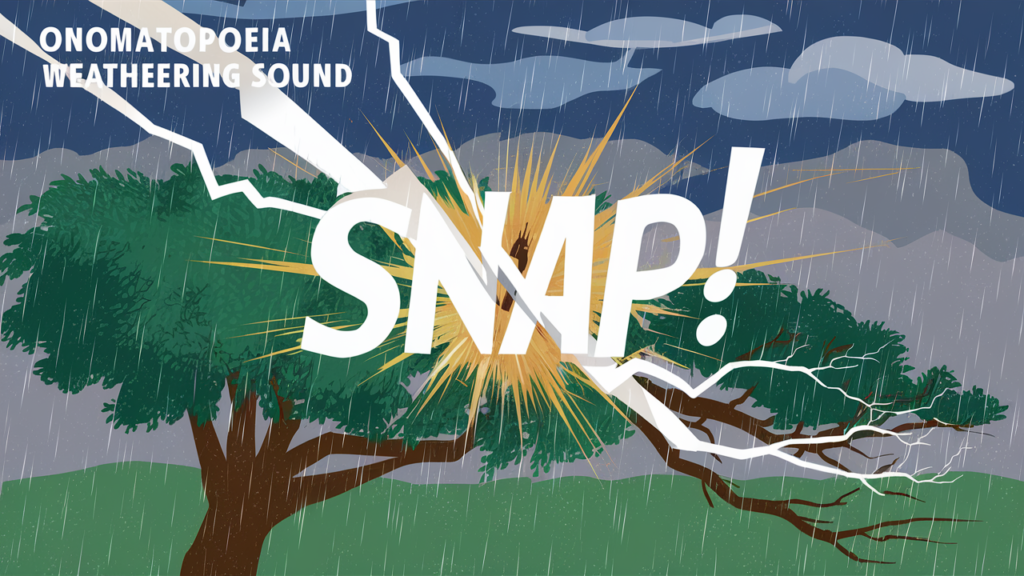onomatopoeia the word snapwith any sentence with weathering is a fun and creative way of using words that sound like the actions or things they describe. “Snap” is one of those words, and it’s a perfect example of onomatopoeia. Imagine you’re walking outside on a crisp autumn day, and you step on a dry twig—snap! That sudden, sharp sound is exactly what “snap” means. It’s an action word that sounds just like the noise it describes, making it easier for us to picture and understand.
Onomatopoeia can also help us imagine different weather conditions. For instance, “snap” could be used to describe the sound of a cold wind cutting through the air during winter. It’s an excellent way to connect language with the world around us. The sound of something snapping, like branches in a storm, or the sudden break of ice underfoot, all relate to weathering in nature. The word “snap” can bring to life the forces of weather and how they shape the world.
Onomatopoeia: The Word ‘Snap’ and Its Connection to Weathering Sounds
Onomatopoeia is a special type of word that imitates the sound it describes. A good example of this is the word “snap.” When you hear the sound of something breaking or snapping, it’s just like the word itself. “Snap” sounds exactly like the noise a twig makes when it breaks or the crack of ice. It’s not just a fun word; it also helps us picture the world around us more clearly. Using onomatopoeia in writing brings stories and ideas to life.
The word “snap” can be especially useful when describing nature. For example, when you walk on frozen ground, and the ice cracks under your feet, the sharp sound is a “snap.” This is an example of how onomatopoeia can be used to describe events in nature, like weathering. Weathering refers to the process of rocks and materials being worn down over time, and words like “snap” can help explain how the earth changes due to weathering forces.
The Role of Onomatopoeia in Describing Weathering Effects

When we think about weathering, we usually imagine wind, rain, and ice slowly breaking down rocks and landforms. Onomatopoeia like “snap” helps us imagine these processes. For example, the wind might blow and make branches snap, or ice could crack and break with a loud snap. The sound of “snap” gives us a vivid image of how weathering happens in nature. It’s a way to connect the feeling of these natural forces with words that everyone can understand.
How Weathering and Onomatopoeia Work Together
Sound of Broken Ice: Ice breaking under pressure during a freeze-thaw cycle makes a distinct “snap.”
Cracking Branches: As trees and plants undergo weathering, branches may snap off with a loud sound.
Erosion Sounds: The erosion of rocks due to wind or water may cause small, sharp sounds like snapping.
Creating Picture-Perfect Weather Scenes with Onomatopoeia
Onomatopoeia like “snap” can be used to create clear pictures of how nature sounds. Imagine standing outside during a winter storm, and you hear branches snapping from the weight of the snow. The “snap” is sharp and sudden, making the weather feel even colder. It’s an easy way to help people feel like they are right there in the storm with you. By using words that sound like their meanings, you can bring weathering and the effects of nature to life.
How Onomatopoeia Like ‘Snap’ Describes the Forces of Weathering

In nature, weathering can be a slow process, but onomatopoeia like “snap” brings that process to life. When rocks crack from freezing water or tree branches break in strong winds, the word “snap” is perfect for describing the sound. It helps explain the sudden change caused by these natural forces. Weathering may not always be loud, but onomatopoeia gives us the tools to feel the power of nature’s changes. Using “snap” in this way helps us understand how weathering shapes the world.
Conclusion
In conclusion, onomatopoeia, like the word “snap,” is a fun way to describe the sounds of nature. It helps us picture how things break, crack, or snap during different weather events. Words like “snap” are not only helpful in stories but also in understanding natural processes like weathering. By using onomatopoeia, we can feel the sharpness of ice breaking or the sound of branches snapping in the wind.
So next time you hear a “snap,” remember it’s more than just a sound. It’s a word that connects us to nature’s forces and shows how weathering shapes our world. Onomatopoeia is an important tool in writing, making the sounds of nature come to life. It’s a simple yet powerful way to make the world around us feel real and vivid.
FAQs
Q: What is onomatopoeia
A: Onomatopoeia is when a word sounds like the thing it describes, like “snap” or “buzz.”
Q: Why is the word “snap” used in weathering
A: “Snap” is used to describe the sound of things breaking, like ice or branches, which happens in weathering.
Q: Can onomatopoeia help in writing stories
A: Yes, onomatopoeia makes stories more fun and helps readers hear and feel the actions in the story.
Q: What does “snap” mean in nature
A: In nature, “snap” often describes the sound of something breaking, like a twig or ice.
Q: How does onomatopoeia relate to weathering
A: Onomatopoeia like “snap” helps describe how rocks and branches break over time due to weathering.




